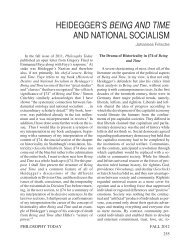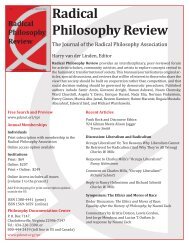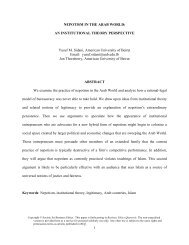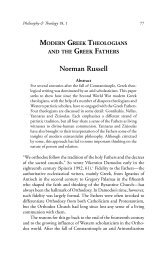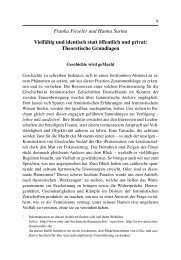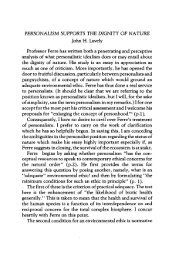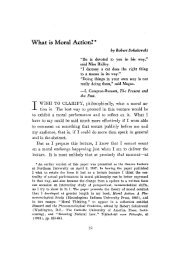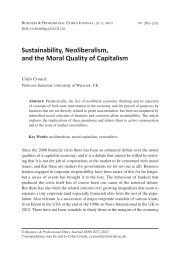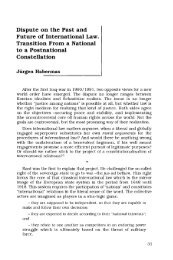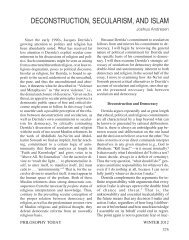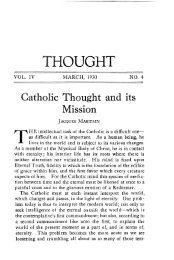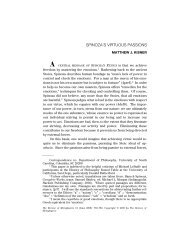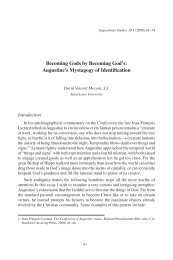The Essay as Self-Knowledge: Montaigne's Philosophical ...
The Essay as Self-Knowledge: Montaigne's Philosophical ...
The Essay as Self-Knowledge: Montaigne's Philosophical ...
You also want an ePaper? Increase the reach of your titles
YUMPU automatically turns print PDFs into web optimized ePapers that Google loves.
74 ANN HARTLE<br />
POETIC ORDER<br />
Montaigne’s appropriation of poetic invention is perhaps most manifest<br />
in the order of his thought. One of the most puzzling <strong>as</strong>pects of<br />
the essay form is the <strong>as</strong>pect of order, for the initial impression is that<br />
there is no order. Montaigne seems to begin just anywhere, to often<br />
wander off the topic, to sometimes hardly even get to the topic. 19<br />
One of the terms that Montaigne uses most frequently to describe his<br />
order is ‘accidental.’ In “Of books,” shortly after advising the reader<br />
to pay more attention to the form than to the matter of the essays,<br />
Montaigne writes: “I have no other marshal but fortune to arrange<br />
my bits. As my fancies present themselves, I pile them up; now they<br />
come pressing in a crowd, now dragging single file. I want people to<br />
see my natural and ordinary pace, however off the track it is” (VS409;<br />
F297). At the beginning of “Of friendship,” he <strong>as</strong>ks: “What are these<br />
[essays] of mine, in truth, but grotesques and monstrous bodies, pieced<br />
together of divers members, without definite shape, having no order,<br />
sequence, or proportion other than accidental?” (VS183; F135).<br />
<strong>The</strong>re is, of course, a numerical ordering of the <strong>Essay</strong>s, but, for<br />
the most part, that too seems accidental. <strong>The</strong> only hint of design that<br />
I detect in the numerical ordering is in essay I.29, “<strong>The</strong> twenty-nine<br />
sonnets of Etienne de la Boétie,” where the number of the essay<br />
matches the number in the title. <strong>The</strong>re are instances in which one<br />
essay is clearly related to another <strong>as</strong> is the c<strong>as</strong>e with II.16, “Of glory,”<br />
and II.17, “Of presumption”: the link is made explicit in Montaigne’s<br />
introductory remarks to II.17. 20 But there are many places in the essays<br />
where an accidental, apparently non-substantive link can be<br />
made. <strong>Essay</strong> I.40 ends with a reference to inscriptions on the title<br />
pages of printed books; at the beginning of essay I.41, he cites Cicero<br />
on the fact that the very authors who write against the concern for<br />
glory make sure that their names appear in the front of their books.<br />
<strong>Essay</strong> I.3 ends with a reference to salted meats, and essay I.4 begins<br />
with the story of the man who cursed salted meats for his attacks of<br />
the gout. <strong>The</strong> thumbs of essay II.26 had already appeared in the<br />
“thumbs down” of the Roman gladiatorial combats in essay II.23.<br />
<strong>The</strong>se are trivial connections, but that is the point. <strong>The</strong> order is accidental,<br />
<strong>as</strong> if some non-essential remark in one essay leads him into<br />
the next. Now there is something artful about this since Montaigne<br />
does not place his essays in strictly chronological order, i.e., we are



